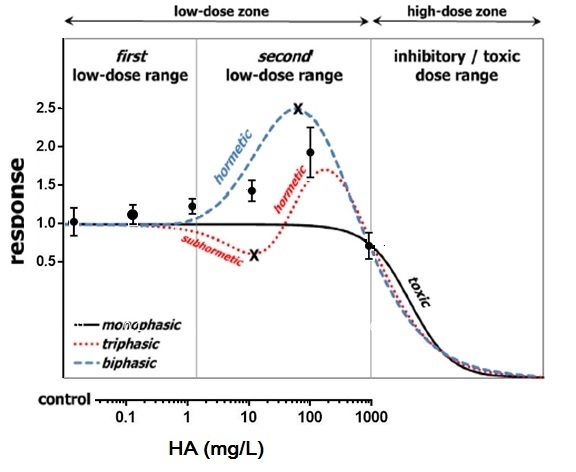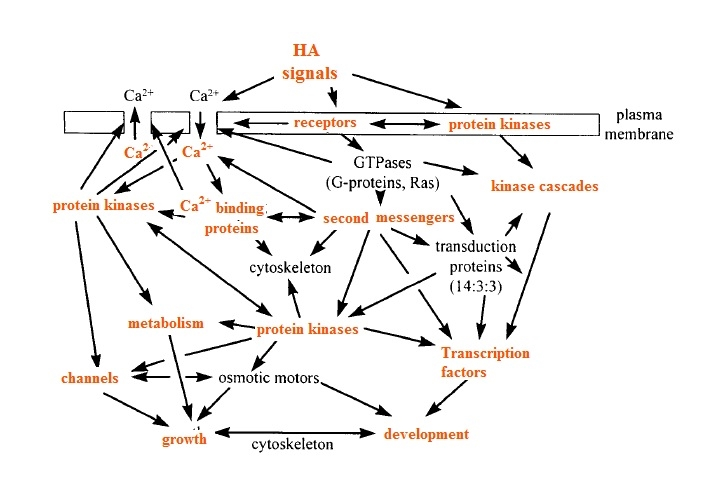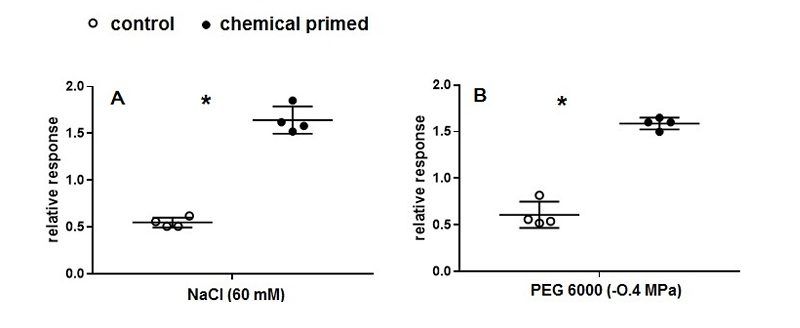BIOSTIMULANTS FOR CHEMICAL PRIMING AS A STRESS MANAGEMENT TOOL FOR CROPS
By: Luciano Pasqualoto Canellas and Fábio Lopes Olivares, Núcleo de Desenvolvimento de Insumos Biológicos para a Agricultura (NUDIBA), Universidade Estadual do Norte Fluminense Darcy Ribeiro (UENF), Campos dos Goytacazes, Rio de Janeiro, Brazil
email: lucianocanellas@gmail.com, fabioliv@uenf.br

The topical challenge of modern agriculture is to combine the maintenance of crop yields with lower energetic inputs within changing environmental conditions. In this scenario, the abiotic stresses become prevalent limiting factors that need to be faced with the development of sustainable approaches to protect soil and plants.
The combination of humic substances and plant growth-promoting bacteria has produced a biostimulant that has been systematically tested on an experimental scale (1) and recently used in large areas of tropical crops.
The increase of microbiological processes such as biological nitrogen fixation, phosphate solubilization, and the biostimulation process is particularly significant given the magnitude of the increasing production costs and environmental impacts. The indirect (most soluble complex) and the direct effect of humic substances on nutrient uptake have been widely reported, and its effect on ion fluxes is one of the most studied issues (2). The stimulation of plasma membrane proton pumps has a central role in ion uptake. These enzymes provide an electrochemical gradient necessary to energize ion transport for cell uptake and induce cell growth by a mechanism known as acid growth, in which H+ acts as the intermediate between auxin and cell wall loosening (3).
The practical results of foliar applying of the biostimulant based on humic substances and plant growth-promoting bacteria have been especially significant on crop production when some type of limitation imposed by abiotic stress are present such as low natural soil fertility (4) or drought (5). Moreover, the strength of the stress factor in the last data meta-analysis of experiments considering the root and shoot growth induced by humic substances cannot be disregarded (6).
The scientific literature concerning the effect of humic substances on the mitigation of abiotic stress damage in plants is abundant, and some relatively recent reviews are available (7, 8, 9, 10). Here we would like to introduce a different aspect considering the biostimulant as tools for crop management strategy, i.e. plant preparation for rapid response against abiotic stress. Chemical priming is a promising field in plant stress physiology and crop stress management. Preconditioning strategy can be utilized to stimulate the adaptation mechanism and enhance the crop resilience capacity and thus limiting the negative impacts on yield quality and productivity. Priming means to elicit and anticipate plant tolerance against environmental challenges by improving physiological performance via the application of chemical or biotic agents (11). Humic acids have been found to act as active priming agents against plants’ abiotic stress in a typical hormesis response (12). Hormesis can be defined as a biphasic response in which high doses of a toxic agent could cause inhibition while a low dose of the same toxic agent can cause stimulation (13). It is characterized by a phenomenon by which a low dose of the stressor anticipates the cellular stress response, including secondary metabolites production, in order to help organisms establish adaptive responses. Humic acids can show a typical hormesis dose-response, i.e. a biphasic dose-response characterized by low-dose stimulation and high-dose inhibition (Fig 1).

[Figure 1]: Typical dose-response curve of humic acids (mg L-1) isolated from vermicompost of cattle manure and maize seedlings root growth (fresh weight) and theoretic dose-dependent changes in response in case of a monophasic, biphasic or triphasic dose-response pattern and quantitative thresholds to separate the low-dose range from a high-dose exposure. This is an adaptation of the original image from Belz and colleagues (14)
Hormesis mechanisms in plants induced by humic substances were recently highlighted (Fig 2). Humic acids and plant growth-promoting bacteria can be used as a chemical priming plant defence agent since seedlings showed typical hormesis response with biphasic dose-response. The prime state induced by humic substances showed a significant transcription level of genes encoding stress perception and cell signalization, including kinases, phosphatases proteins, and functional and regulatory (transcription factors) proteins, which are involved in gene response against abiotic stress (12). The further exposition of chemically primed maize seedling to abiotic stress agents resulted in an apparent increase of plant tolerance against abiotic stress, including osmotic stress (Fig 3).

[Figure 2]: Hormesis mechanisms induced by humic acids related to signal transduction network in plant cells. Coloured steps indicate that signals were altered by humic treatments producing changes in membrane potential, occuping and activating plasma membrane receptors, or modifing protein kinases. The Ca2+ cytosolic pulse was previously measured by an ion-selective vibrating probe system and the Real-Time quantitative PCR to measure the differential expression of voltage-dependent channels and kinases (15). Other second messengers induced by humic acids were previously described by García and colleagues (16) that observed regulation of oxygen reactive species production at a cellular level. The activation (down or upregulation) of different transcription factors and the high transcription level of specific abiotic gene response in the prime state induced by humic acids isolated from vermicompost were also found (12). The figure is an adaptation of the original scheme proposed by Trewavas and Malhó (17) to describe the signal transduction network in plant cells.
[Figure 3]. Recovery of root growth (fresh weight) after maize seedlings exposure of osmotic stress due to salinity (A) and (B) drought. The maize seedlings were previously conditioned (chemical primed) or not (control) with four mM C from humic acids isolated from vermicompost to 48 hs and further submitted to osmotic stress for seven days. * The means (n=6) were different by F test (P<0.05).

We highlighted two main characteristics concerning crop management using biostimulant manufactured with humic substances: i) Broad-spectrum activity. Since plant defence priming is a state of enhanced defence readiness, which has been associated with enhanced levels of pattern-recognition receptors, priming helps defeat a broad spectrum of biotic or abiotic stress related to non-specific priming stimulus induced by humic substances and ii) Low ecological costs. The low humic concentration that induces priming state are not toxic for the organisms nor the environment and are without risk to human health.
The practical application of biostimulant in crop stress management needs future field research to understand the adequate moment of application to protect against future and uncertain action of multiple and simultaneous abiotic stress agents. Although the hormesis mechanisms in plants induced by humic acids had been relatively understood, some basic questions remain: (a) how many times is necessary to apply the biostimulants; (b) what is the best physiological stage to trigger the prime state; (c) if this response is transgenerational, among others.
- Olivares FL, Busato JG, Paula AM, Lima LS, Aguiar NO, Canellas LP. Plant growth-promoting bacteria and humic substances: crop promotion and mechanisms of action. Chem Biol Technol Agric. 2017; 4:30.
- Azevedo IG, Olivares FLO Ramos ACR, Bertolazi AA, Canellas LP. Humic acids and Herbaspirillum seropedicae change the extracellular H+ flux and gene expression in maize roots seedlings. Biol. Technol. Agric. 2019; 6:8.
- Canellas LP, Martínez-Balmori D, Médici LO, Aguiar NO, Campostrini E, Rosa RC, Facanha A, Olivares FL. 2013. A combination of humic substances and Herbaspirillum seropedicae inoculation enhances the growth of maize (Zea mays). Plant Soil 366, 119–132.
- Canellas LP, Olivares FL, 2014. Physiological responses to humic substances asplant growth promoter. Chem. Biol. Technol. Agric. 1, 1–11
- Aguiar NO, Medici LO, Olivares FL, Dobbss LB, Torres-Netto A, Silva SF, Canellas L P. Metabolic profile and antioxidant responses during drought stress recovery in sugarcane treated with humic acids and endophytic diazotrophic bacteria. Ann. Appl. Biol. 2016;. 168:203-213.
- Rose MT, Patti AF, Little KR, Brown AL. A meta-analysis and review of plant-growth response to humic substances: practical implications for agriculture. Adv Agron. 2014; 124:37-89.
- Olk DC, Dinnes DL, Rene Scoresby J, Callaway CR, Darlington JW. Humic products in agriculture: potential benefits and research challenges -a review. Soils Sediments. 2018;18:2881-2891.
- Olaetxea M, Hita D, García AC, Fuentes M, Baigorri R, Mora V, Garnica M, Urrutia O, Erro J, Angel Mª Zamarreño A M, Berbara RL, Garcia-Mina JM. Hypothetical framework integrating the main mechanisms involved in the promoting action of rhizospheric humic substances on plant root- and shoot growth. Appl Soil Ecol. 2018;123:521-537. http://dx.doi.org/10.1016/j.apsoil.2017.06.007
- Shah ZH, Rehman HM, Akhtar T, Alsamadany H, Hamooh BT, Mujtaba T, Daur I, Al Zahrani Y, Alzahrani HAS, Ali S, Yang SH and Chung G. Humic substances: determining potential molecular regulatory processes in plants. Front Plant Sci. 2018;9:263.
- Pukalchik M, Kydralieva K, Yakimenko O, Fedoseeva E, Terekhova V. Outlining the Potential Role of Humic Products in Modifying Biological Properties of the Soil -A Review. Front. Environ. Sci. 2019;7:80.
- Agathokleous E, Kitao M, Calabrese EJ. Hormesis: a compelling platform for sophisticated plant science. Trends Plant Sci 2019; 24:(4)318-327.
- Canellas LP, Canellas NOA, da S. Irineu LES, Olivares FL, Piccolo A. Plant chemical priming by humic acids. Chem Biol Technol Agr. 2020 accepted; manuscript number 10.1186/s40538-020-00178-4
- Calabrese, E.J., Baldwin, L.A., 2002. Defining hormesis. Hum. Exp. Toxicol. 21, 91–97.
- Belz RG, Patama M, Sinkkonen A. from Low doses of six toxicants change plant size distribution in dense populations of Lactuca sativa. Science of the Total Environment 631–632 (2018) 510–523
- Ramos AC, Olivares FL, Silva LS, Aguiar NO, Canellas LP. Humic matter elicits proton and calcium fluxes and signalling dependent on Ca2+-dependent protein kinase (CDPK) at early stages of lateral plant root development. Chem Biol Technol Agric. 2015;1:1–12 DOI 10.1186/s40538-014-0030-0
- Garcia, A.C., Olaetxea, M., Santos, L.A., Mora, V., Baigorri, R., Fuentes, M., Zamarreño, A.M., Berbara, R.L., Garcia-Mina, J.M., 2016a. Involvement of hormone- and ROSsignaling pathways in the beneficial action of humic substances on plants growing under normal and stressing conditions. BioMed. Res. Int. 13ID 3747501
- Trevavas AJ, Malhoó R. Signal perception and transduction: the origin of the phenotype. The Plant Cell, Vol. 9, 1181-1 195, 1997.



